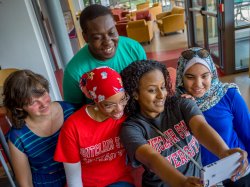Deliver course content that actively integrates, interrogates, and seriously engages with the diversity of perspectives and experiences that a scholarly, responsible treatment of the subject demands. Use pedagogies of inclusion that enable all students to feel known, seen, and valued to encourage learning and growth.
Inclusive teaching has two main elements: incorporating diverse perspectives in course materials and employing inclusive teaching practices. Most instructors support inclusion and diversity but putting these values into practice can be difficult. In these pages strategies and resources used by faculty across the disciplines are shared
Incorporating Diverse Perspectives in Course Materials
Understanding diverse experiences is critical for all students’ deep learning, so take time to select content to support, facilitate, and interrogate barriers to inclusion.
Employing Pedagogies of Inclusion
Using inclusive teaching strategies and cultivating an inclusive classroom climate helps all students learn and prepares them for the world beyond the University.
Cultivating Diversity, Equity, Inclusion, Belonging
Taking actions to support students’ appreciation for diversity and their experience of your class as equitable, inclusive, and one in which they belong can powerfully affect students’ learning.
Pedagogical Strategies for Intercultural Learning
Adapted from a talk by Prof. Milton Fuentes, these strategies will help you discuss equity, inclusion, and diversity (EDI) in the classroom, and apply an EDI-centered approach to course development.
Discussing Equity: Using Protocols to Deepen Conversation and Raise Intellectual Engagement
Adapted from a presentation by Prof. Patricia Virella, this guide will help you create an environment in which deep conversations about equity and other sensitive issues can flourish.
Mitigating Implicit Bias
Taking actions to recognize and mitigate implicit bias supports students’ sense of belonging and success.
Universal Design for Learning (UDL)
Design and deliver all course elements for maximum accessibility to give every student equitable opportunities for success.
Ambrose, S.A., Bridges, M.W., DiPietro, M., Lovett, M.C., & Norman, M.K.(2010). How Learning Works: Seven Research-Based Principles for Smart Teaching. John Wiley & Sons. Ladson-Billings, G. (1995). Toward a Theory of Culturally Relevant Pedagogy. American Educational Research Journal, 32(3), 465–491. https://doi.org/10.2307/1163320 Davis, B.G. (2009). Tools for Teaching. Second Edition. John Wiley & Sons. Eddy, S.L., & Hogan, K.A. (2014). Getting Under the Hood: How and for Whom Does Increasing Course Structure Work? CBE–Life Sciences Education, 13, 453-468. https://doi.org/10.1187/cbe.14-03-0050 Hockings, C.(2010). Inclusive Learning and Teaching in Higher Education: A Synthesis of Research. Higher Education Academy. Landrum, R.E., & McCarthy, M.A. (Eds.). (2012). Teaching Ethically: Challenges and Opportunities. American Psychological Association. Lee, A., Poch, R., Shaw, M., & Williams, R. Engaging Diversity in Undergraduate Classrooms: A Pedagogy for Developing Intercultural Competence. ASHE Higher Education Report 38, no. 2. John Wiley & Sons, 2012. “Online Equity Rubric.” Peralta Community College District Distance Education. https://f.hubspotusercontent00.net/hubfs/6398505/Peralta-Online-Equity-Rubric-3.0-Oct-2020.pdf Sellers, S. et al. Reaching All Students: A Resource for Teaching in STEM. Center for the Integration of Research, Teaching, and Learning (CIRTL), last modified 2007, accessed July 19, 2017. https://career.ucsf.edu/sites/career.ucsf.edu/files/PDF/Researchersreachingallstudents.pdf Tobin,T.J., & Behling, K.T. (2018). Reach Everyone, Teach Everyone: Universal Design for Learning in Higher Education. West Virginia University Press. Yancy, G. and Davidson, M.D.(2014). Exploring Race in Predominantly White Classrooms: Scholars of Color Reflect. Routledge. For more information or help, please email the Office for Faculty Excellence or make an appointment with a consultant. Third-party content is not covered under the Creative Commons license and may be subject to additional intellectual property notices, information, or restrictions. You are solely responsible for obtaining permission to use third party content or determining whether your use is fair use and for responding to any claims that may arise.
![]()
Teaching Resources by Montclair State University Office for Faculty Excellence is licensed under a Creative Commons Attribution-NonCommercial 4.0 International License
